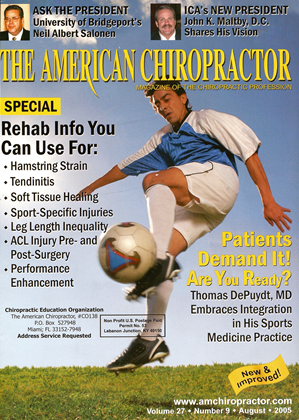THE REHABILITATION PROCESS FOR INJURED ATHLETES IS OFTEN divided into three distinct phases: acute, recovery and functional.1 A comprehensive rehabilitation plan will include different types of exercises tailored for each of the three healing phases. Each phase is important fora successful return to sports activity, but the last one may be the most critical, and is the one that is frequently overlooked in the rush to get back into the game. Acute Phase Immediately after an injury, there will be variable amounts of pain, swelling, weakness, muscles fatigue, limited range of motion, joint locking or instability, and decreased sports performance. Pain and swelling are indicators of inflammation due to tissue damage, and require immediate attention. Frequent cooling of the damaged tissue will limit bleeding and swelling and help to control pain. Protection of injured areas with taping or a brace may be necessary for a short period of time, in order to minimize additional tissue damage. Carefully controlled active exercising should be initiated once the inflammation has begun to subside and the pain levels begin to drop. Since isometric exercises produce strength gains mainly at the joint angle used,2 dynamic training in a pain-free range should be initiated as soon as it can be tolerated. Electrical stimulation with high volt electrotherapy can maximize motor unit recruitment in this stage, while helping control excessive pain.1 Initially, only a light external load (such as exercise tubing with some slack) should be used, but this can be gradually progressed based on the tolerance and pain levels of the athlete. Recovery Phase Returning to sport activities prior to regaining full range of motion is risky, so joint mobility and flexibility exercises are crucial in the early recovery stage. To be effective, stretching exercises should be done two or three times a day, with a minimum of three repetitions of approximately 30 to 60 seconds for each muscle group. Stretches should be performed on tissues that have been heated above resting body temperature, using either an active warm-up or external heating, such as a hot tub or heating pad. Daily dynamic resistance exercises to increase strength should be started as soon as they can be tolerated, in order to avoid atrophy and ensure a rapid return to sport activities. Both the concentric and eccentric muscle actions should be worked with gradually increasing resistance and range of motion.4 Elastic exercise tubing has been found to be a safe and effective method of providing progressive resistance exercises with an aerobic component.5 Functional Phase This is the rehab phase that prepares an injured athlete to return to regular training sessions and competition. Exercises now must become more functionally oriented and are designed to simulate the demands of the patient's sport. This "sport-specific training" incorporates movements and activities that train and coordinate specific muscle actions and reactions that are needed for the athlete's sports performance. Obviously, an accurate evaluation of the metabolic and neuromuscular demands of the sport is helpful, so that specific muscle activation patterns can be trained.6 The functional phase focuses on the rehabilitation and conditioning of the entire kinetic chain, and may need to progress into specialized training for explosive strength, such as plyometric exercises. Conclusion Current rehabilitation concepts now emphasize functional activities and re-training of normal loading and movement patterns. Appropriate and progressive rehab programs should be started early in the treatment of all patients with sports or exercise injuries and should be planned to take place simultaneously with the biological healing of the injured tissues. A large body of literature shows the advantage of early, progressive rehabilitation exercise for all types of sports injuries. These benefits include restoration of range of motion, decreased pain, decreased neural inhibition, quicker return of muscle function, and improved perfonnance in both sports and normal daily activities. Elastic tubing strength retraining programs, comprised of simple, isotonic resistance techniques, are readily available, none of which require expensive equipment or great time commitments. This allows the doctor of chiropractic to provide cost-efficient, yet very effective and sport-specific rehabilitation care.i See references on pg. 62 Dr. Hyland is board-certified in two chiropractic specialties, and is also certified as a Strength and Conditioning Specialist and a Health Education Specialist. He has 20 years of clinical practice; for eight years he specialized in chiropractic rehabilitation. He is currently a Research Associate at Parker College of Chiropractic, and an Adjunct Professor of Clinical Sciences at the University of Bridgeport's College of Chiropractic. You can contact him at [email protected].
 View Full Issue
View Full Issue






